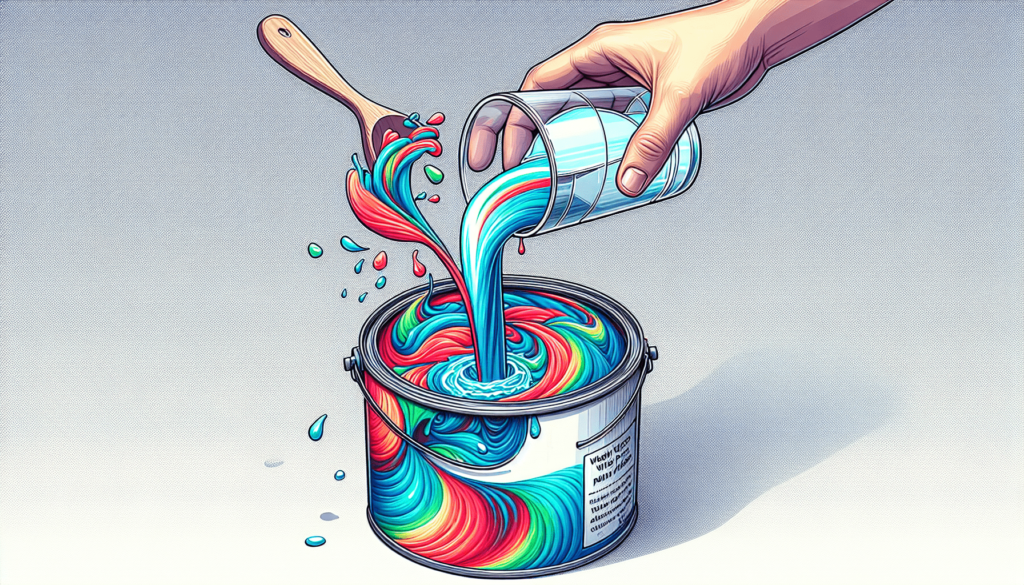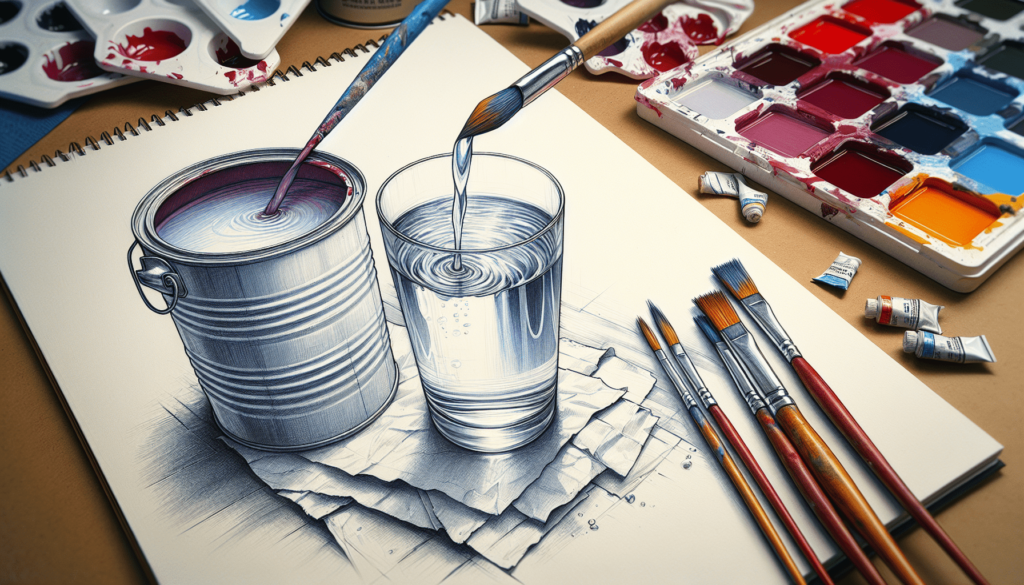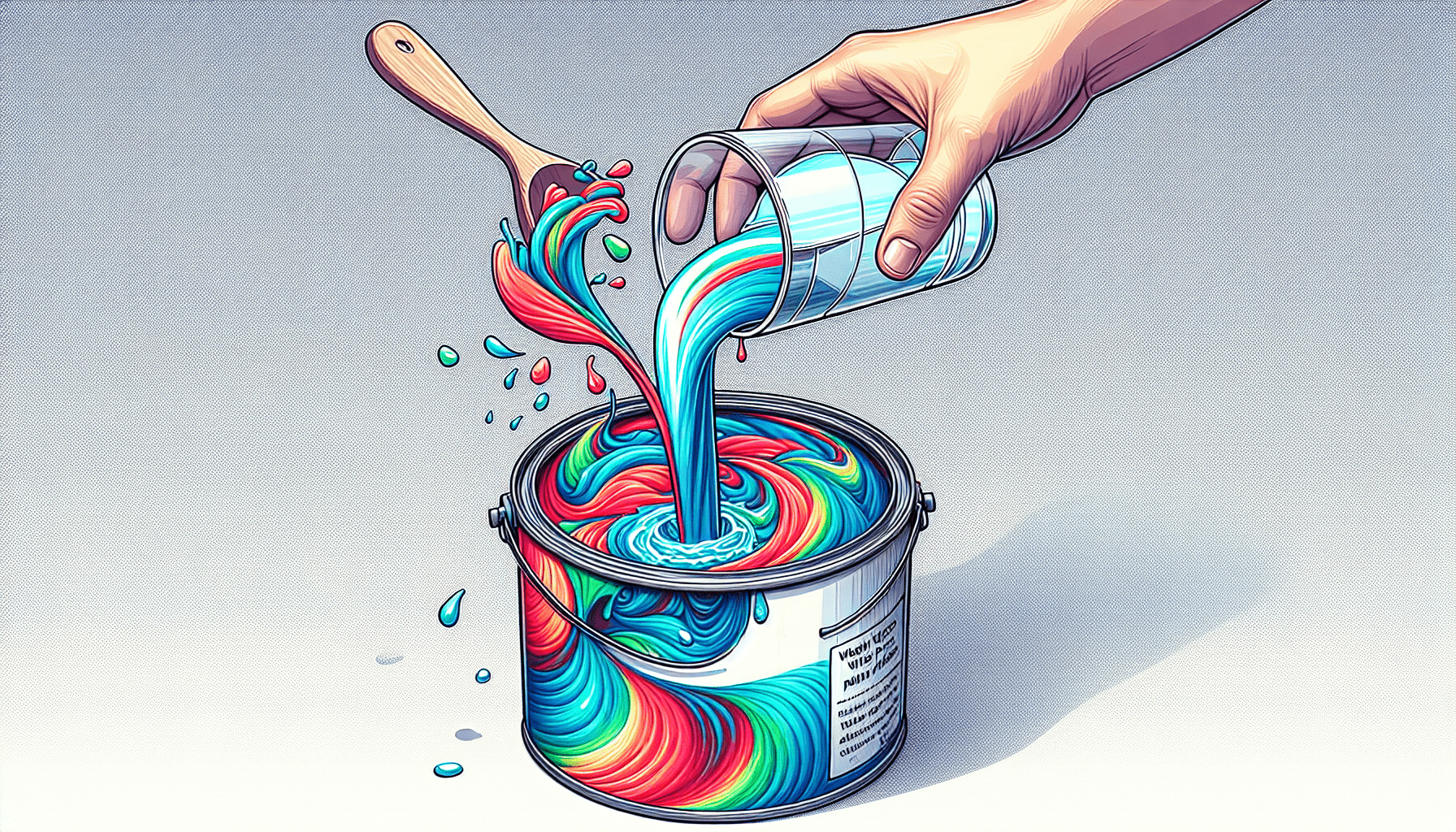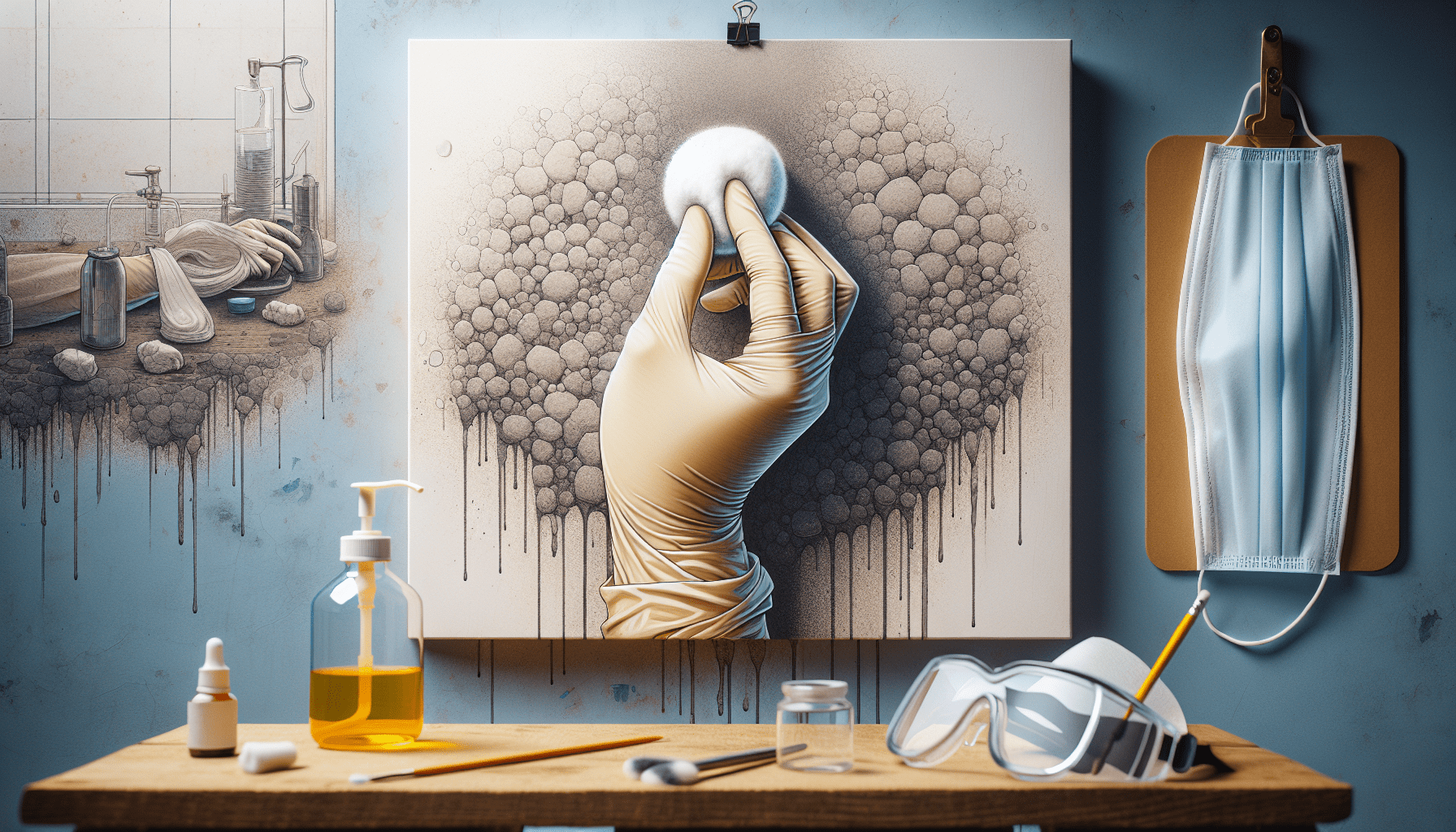In the world of painting and home improvement, it is common practice to wonder if water can be added to latex paint. Understanding the compatibility and potential effects of adding water to latex paint is crucial for achieving the desired finish and durability of your project. This article provides insights into the pros and cons of adding water to latex paint, ensuring that you can make an informed decision when it comes to your painting endeavors.
Understanding Latex Paint
Latex paint is a type of water-based paint that is commonly used for various interior and exterior applications. It is composed of several key components, including pigments, binders, solvents, and additives. Understanding the composition of latex paint is crucial in determining whether it can be diluted with water and the possible effects of doing so.
Composition of Latex Paint
Latex paint primarily consists of water as its base. It also contains a binder, which is typically a synthetic latex material that ensures adhesion and durability. Pigments are added to provide color, while additives such as thickeners, surfactants, and preservatives enhance various properties of the paint. In most cases, the water content in latex paint constitutes a significant portion of its overall composition.
Water Content in Latex Paint
The amount of water in latex paint varies depending on the specific formulation and brand. Generally, latex paint has a water content ranging from 60% to 70%. This high water content contributes to its easy application, fast drying time, and low odor. However, it also means that latex paint can be thinned by adding additional water, making it more fluid and potentially altering its properties.
Effects of Adding Water to Latex Paint
The decision to add water to latex paint can have various effects on its performance and characteristics. It is essential to understand these potential effects before attempting to dilute the paint.
Thickness and Coverage
Adding water to latex paint reduces its viscosity, making it thinner and easier to apply. As a result, the paint may have reduced coverage, requiring additional coats to achieve the desired finish. Dilution also affects the thickness of each coat, potentially affecting the hiding ability of the paint and the evenness of the final result.
Color Dilution
Diluting latex paint with water may alter its color intensity. The pigments in the paint may become diluted, resulting in a lighter or less vibrant color. It is important to consider this potential color dilution when deciding whether to add water and to ensure consistent color across the project by mixing a larger quantity of diluted paint.
Adhesion and Durability
Adding water to latex paint can impact its adhesion and durability. The binder in the paint is responsible for binding the pigments and ensuring they adhere to the surface. Dilution with water may weaken the binder, leading to reduced adhesion and durability of the paint film. This can result in premature chipping, peeling, or cracking of the painted surface.
Dry Time and Curing
Water acts as a drying agent in latex paint, and adding more water can prolong the drying time. Thinning the paint excessively with water can increase drying time, impede proper curing, and compromise the overall quality of the paint film. It is important to strike a balance between achieving the desired consistency and maintaining proper drying and curing properties.
Freezing and Thawing
Adding water to latex paint can affect its freeze-thaw stability. When water is added, the paint may become more susceptible to freezing at low temperatures. Freezing can cause irreversible damage to the paint, resulting in changes in viscosity, separation of components, or loss of quality. Therefore, it is crucial to consider the freezing and thawing characteristics of the paint, especially in cold climates.

When Can You Add Water?
The opportune time to add water to latex paint depends on its freshness, how much has been used, and its overall condition. While adding water can be done in certain circumstances, there are limitations to consider.
Freshly Purchased Latex Paint
Freshly purchased latex paint usually has the ideal consistency and does not require water dilution. It is already formulated with the appropriate water content to provide optimal performance. Adding water to brand new paint may result in unintended consequences and compromise the quality of the product.
Partially Used Latex Paint
If you have a partially used can of latex paint that has thickened over time, adding water may be a viable option. Before adding water, thoroughly stir the paint to break up any settled solids. If the paint hasn’t thickened significantly, stirring alone may restore its original consistency. However, if the paint remains too thick, consider adding water in small increments and test the consistency until the desired thickness is achieved.
Old or Expired Latex Paint
Old or expired latex paint may not be suitable for adding water. Over time, the components in the paint can degrade, leading to changes in viscosity, stability, and overall quality. It is generally recommended to discard old or expired paint rather than attempting to revive it by adding water. Using compromised paint can result in subpar performance and unsatisfactory results.
How to Add Water to Latex Paint
Adding water to latex paint requires proper preparation, testing, and mixing techniques to achieve the desired consistency without compromising the paint’s performance.
Gather the Necessary Materials
Before you begin adding water to latex paint, ensure you have all the necessary materials. This includes a clean container for mixing, a stirring stick or paint mixer, water, and a measuring device if precise water ratios are desired.
Preparation and Testing
To ensure the suitability of water dilution, inspect the paint for any signs of spoilage or separation. Thoroughly stir the paint to ensure uniformity. If the paint appears lumpy or excessively thick, test a small amount by applying it to a test surface or mixing board. Observe the consistency, coverage, and drying time to assess and adjust as needed.
Adding Water
When adding water to latex paint, it is crucial to introduce it gradually. Start by adding small increments of water and mix thoroughly before evaluating the consistency. Slowly increase the amount of water until the desired viscosity is achieved. Be cautious not to over-thin the paint, as it may compromise its performance and durability.
Mixing Properly
When adding water, mix the paint thoroughly to ensure proper dispersion. Use a stirring stick or paint mixer to incorporate the water evenly into the paint. Pay attention to any settled solids or pigments that may require additional mixing to achieve uniform consistency. Adequate mixing guarantees a homogeneous mixture that will perform consistently across the painted surface.

Water Ratios for Diluting Latex Paint
Determining the appropriate water ratio for diluting latex paint can be subjective and may vary based on personal preference and the specific project requirements. However, general guidelines and specific recommendations can serve as starting points.
General Guidelines
As a general rule, it is recommended to add water in small increments, starting with a ratio of approximately 5% water to paint. Evaluate the consistency after each addition and adjust as needed. Avoid excessive dilution, as it may compromise the paint’s performance and result in unsatisfactory results.
Specific Recommendations
Different projects and application methods require varying consistencies. For brush or roller application, a water ratio of 10% to 20% is often sufficient. However, for spray application, a higher water ratio of 20% to 30% may be necessary to achieve the desired sprayability and coverage. Keep in mind that these are only recommendations, and personal experimentation may be required to find the optimal water ratio for specific applications.
Alternatives to Water for Thinning Latex Paint
While water is commonly used to thin latex paint, there are alternative substances that can achieve similar results. These alternatives offer distinct benefits and may be preferred in certain situations.
Commercial Paint Thinners
Commercial paint thinners are specifically formulated to thin various types of paint, including latex paint. They often contain solvents such as mineral spirits or naphtha, which can effectively reduce viscosity without affecting the paint’s performance. Paint thinners may be preferable when a stronger diluting agent or a slower drying time is desired.
Floetrol or Penetrol Additives
Floetrol and Penetrol additives are proprietary products designed to improve the flow and leveling properties of latex paint. They can also act as thinning agents, allowing for smoother application and enhanced coverage. These additives are commonly used in situations where improved workability and minimized brush or roller marks are desired.
Best Practices for Adding Water to Latex Paint
To ensure optimal results when adding water to latex paint, there are several best practices to follow. These practices help maintain paint quality, achieve desired consistency, and promote efficiency.
Consulting Manufacturer Guidelines
It is highly recommended to consult the manufacturer’s guidelines for the specific latex paint you are using. Different brands and formulations may have specific instructions or limitations regarding the addition of water. Following these guidelines ensures that the paint’s integrity is preserved and the desired outcome is achieved.
Avoiding Over-thinning
One crucial aspect to consider is avoiding over-thinning the paint. Over-dilution can lead to poor coverage, reduced hiding ability, decreased adhesion, and compromised durability. Continuously evaluate the consistency during the addition of water and stop once the desired thickness or sprayability is achieved.
Mixing Larger Quantities
When mixing diluted latex paint, it is often advantageous to mix larger quantities at once. This ensures consistent color and consistency across the entire project. Mixing smaller batches separately can result in slight variations, leading to visible differences in color or thickness on larger surfaces.
Storing and Reusing Diluted Paint
If you have leftover diluted paint, proper storage is essential to maintain its quality. Ensure the container is tightly sealed to prevent evaporation and contamination. Label the container with relevant information, including the date of dilution and the paint color. When reusing diluted paint, evaluate its condition and consistency before proceeding to ensure satisfactory results.
Common Questions and Concerns
Several common questions and concerns often arise when considering whether to add water to latex paint. Here are answers to a few of them:
Can water be added to primers or sealers?
Yes, water can be added to some primers or sealers to achieve the desired consistency. However, it is important to consult the manufacturer’s guidelines for specific instructions and limitations.
Can water be added to oil-based paints?
No, water should not be added to oil-based paints. Oil and water do not mix, so attempting to dilute oil-based paint with water will not achieve the desired result. Instead, use the appropriate thinner recommended for oil-based paints.
Can water be added to powdered or solid latex paint?
Yes, water can be added to powdered or solid latex paint to reconstitute it into a usable form. Follow the manufacturer’s instructions regarding water ratios and mixing techniques for powdered or solid paints.
Precautions and Limitations
While adding water to latex paint can be a useful technique, it is important to be aware of potential precautions and limitations.
Possible Paint Quality Issues
Adding excessive water or using water of poor quality can lead to compromised paint quality. This may result in reduced adhesion, increased drying time, poor coverage, or even complete paint failure. Always use clean water and avoid over-thinning to minimize the risk of paint quality issues.
Incompatibility with Certain Surfaces
Diluted latex paint may behave differently on certain surfaces compared to its undiluted form. Some surfaces may not tolerate the additional water content, leading to poor adhesion or unsatisfactory results. Test diluted paint on a small inconspicuous area or consult with professionals before applying it to a significant area.
Environmental and Safety Considerations
When adding water to latex paint, be mindful of the environmental and safety considerations. Ensure proper ventilation when working with paint, follow all safety instructions, and dispose of any leftover paint or water responsibly according to local regulations.
Conclusion
Adding water to latex paint can be a valuable technique to achieve the desired consistency and application properties. However, it is crucial to understand the potential effects and follow proper techniques to ensure optimal results. By considering factors such as thickness, color dilution, adhesion, and dry time, you can effectively navigate the process of adding water to latex paint and achieve the desired outcome. With careful consideration and adherence to best practices, you can successfully utilize water as a tool to enhance your latex paint projects.



